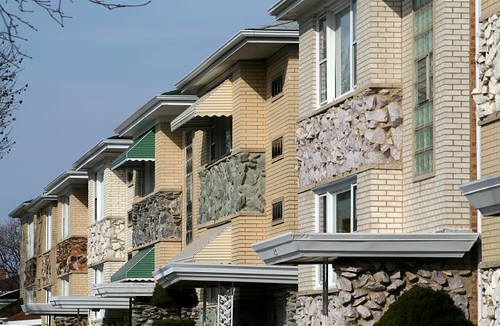
The middle decades of the Twentieth Century are more complicated than that, however, and like all aspects of culture, architecture too had quite a few contradictory influences.
Chicago's MidCentury building stock, simple though it may seem, draws from a broad range of cultural influences. The clean and largely unadorned lines, the glass block (a very modern material), the broad picture windows, and the minimalist, geometric decoration, are the influence of High Modernism.
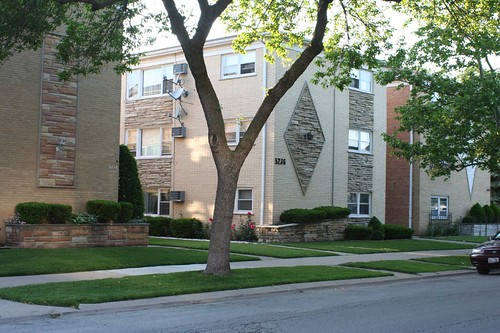
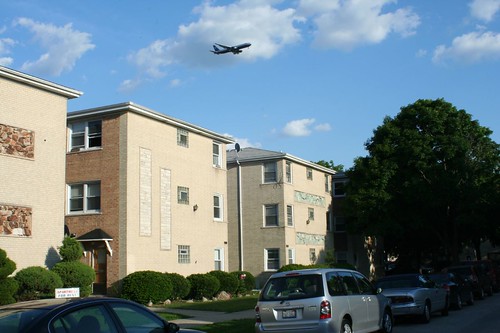
(The windows, by the by, are the clearest evidence that Chicago builders were not really interested in the high ideals of Modernism. Modernists proclaimed the liberation of the wall from structure. The wall could be anything, they said: glass, metal panels, whatever building materials were at hand. Nowhere was this more clearly expressed than at the corners. Corners traditionally were solid, as they had to hold up the building; Modernists delighted in having windows wrap the corner, showing the world that the wall was a free-floating object, rather than a load-bearing mass. Chicago builders, however, almost never used this design trope -- perhaps because, underneath the Modernist trappings, their buildings were still fairly traditional wood-framed structures sheathed mostly in Chicago common brick. The back sides of many Chicago MCM apartment buildings look exactly like their pre-War contemporaries whose backs face the Elevated in the older parts of town.)
The Prairie School brought in elements of horizontality and natural forms and materials -- the rough fieldstones and boulders that adorn the walls of countless MidCentury apartments in Chicago, and perhaps the more organic forms seen in the sculpted glass blocks common on the south side. The stones, however, can also be seen as evoking several other ideals: the rough terrain of the desert southwest (freshly accessible at the time via the nation's growing highway system), and the volcanic rocks of Hawaii and Polynesia (also seen in the thriving Tiki culture of the time.)
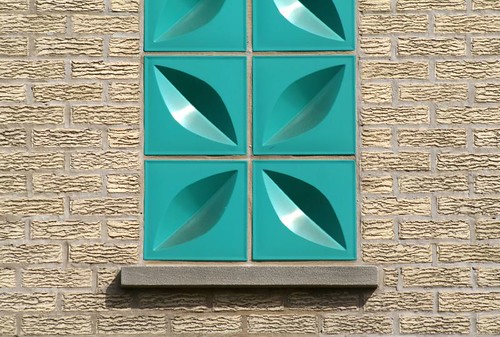
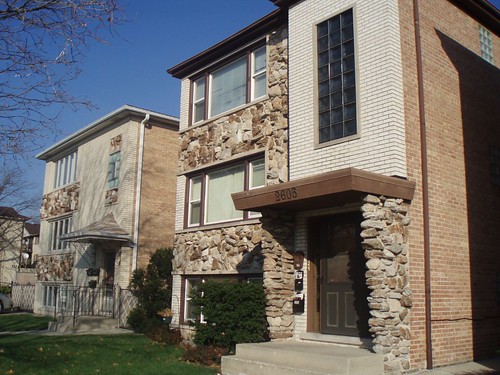
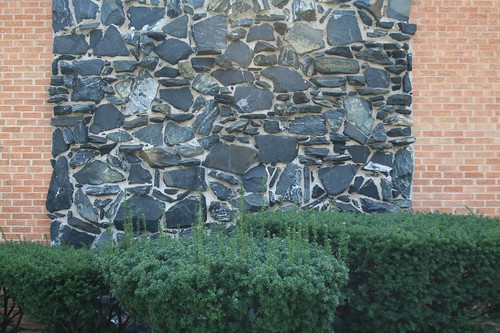
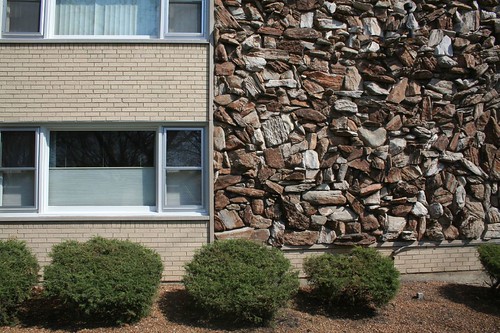
Plant life is another part-and-parcel of Chicago Midcentury. The ideal Chicago bungalow or three-flat has meticulously sculpted shrubs growing outside of it, or perhaps an evergreen.
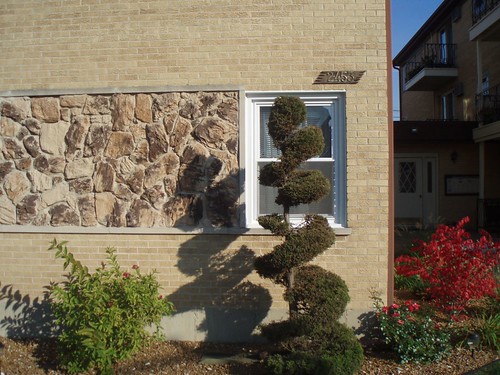
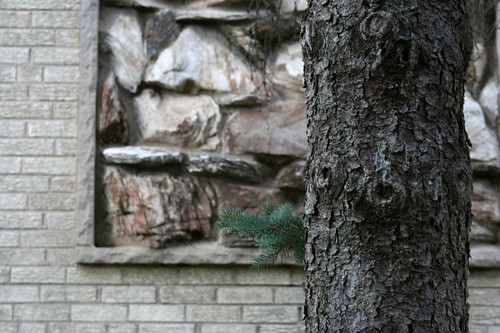
The contemporary style of the New Formalism had a heavy hand as well. It can be seen in the form of repeating arch shapes (including the very same fieldstone wall decorations), stylized lamps strategically placed as objects of elegant, isolated adornment, and in the cream-and-brown color palette of a certain brand of suburban houses.

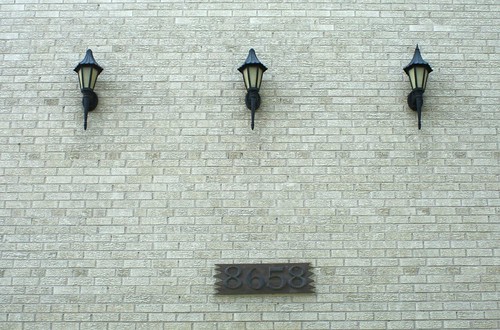
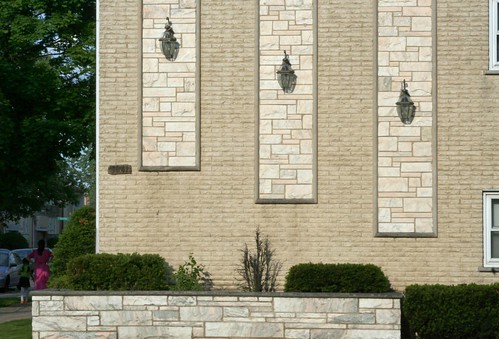
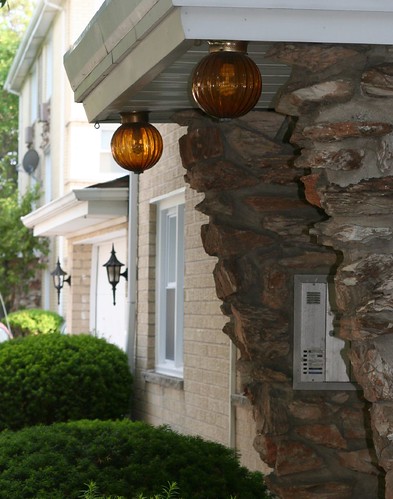
But beyond all these contemporary influences, the past played a role as well. America being a relatively young country, two great periods of glory stand out and seem prominent in the mind of the 1950s: the Colonial era and the Old West.
Old West nostalgia was at a peak in the 1950s, driven by Western flicks at the movies and a surge of television shows. Perhaps it makes a certain amount of sense: with the closing of the frontier passing out of living memory, it would become much easier to romanticize that wilder, untamed time. The ongoing space race was sold to the public under the guise of "The New Frontier", but the old frontier was just as easy for builders to evoke.
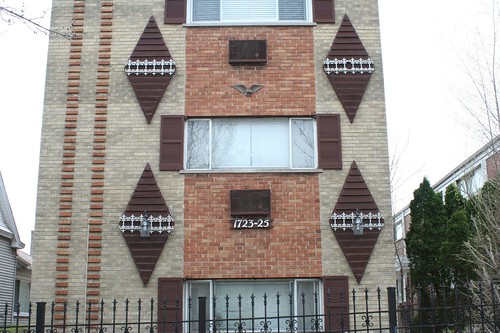
This building on Estes is perhaps the most flagrant example imaginable. It has faux shutters (nowhere nearly big enough to cover that very modern picture window), faux clapboard siding, the obligatory old-styled lamps, and a metal-relief eagle. An eagle!
Any doubts that I'm misinterpreting this should be dispelled by the laundromat sign right up the street.
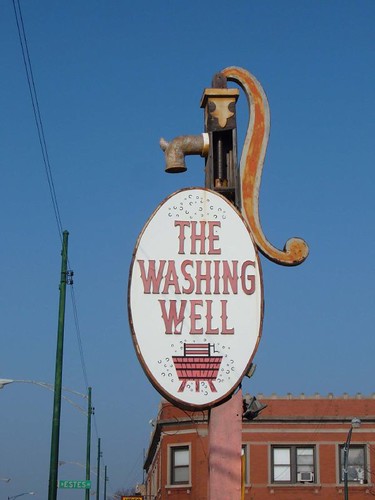
The apartment on Estes is not alone, though. On Touhy near the lake, a series of townhouses features the same eagles, along with shutters and pedimented porch roofs perhaps intended, along with the red brick, to evoke Colonial America. Their layout -- pairs of rowhouses facing each other along a common courtyard, perpendicular to the street -- is quite modern, but their trappings are purely backward-looking.

And look at that fence! If that isn't intended to call out images of frontier forts, nothing is.
The most ubiquitous Old West element of Chicago MidCentury, however, is the wood number plate. Proper capital-M Modernists would never used a serif font on their buildings. Serifs were decoration, decoration was The Enemy, and lettering was Arial font or some equally minimalist font, or nothing at all.
The men who built Chicago, however, were not Proper Modernists. Thousands of apartments and houses have their house numbers proclaimed on little strips of wood with ragged edges seemingly meant to look like jagged splinters, as if this were a random chip left over from splitting firewood, with curved and serifed fonts.

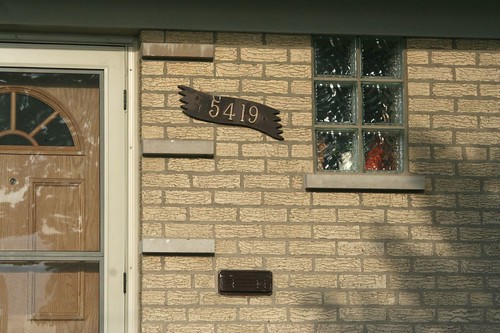
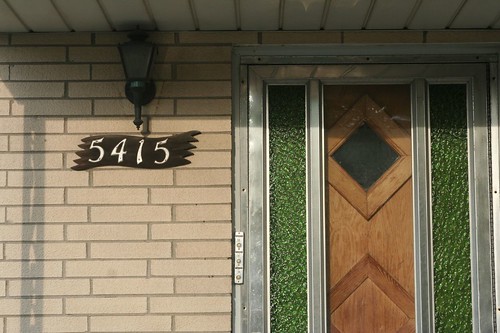
All these elements were thrown into the pot, swirled around, boiled down, and distilled by architects and builders who clearly knew how to appeal to contemporary sensibilities. They were selling an image: Modern elegance, life on the suburban frontier, clean but natural design. And sell it did, as testified by the thousands of buildings that went up in the Chicago MCM style and still stand today.
4 comments:
Outstanding post
Well done! Heading to Chicago Thursday and want to see for myself!
Jeannine
I Live In Chicago I Wonder Are Those Building Houses Or Apartments?
I have been wondering for a long time if those styled houses are houses or apartments?
Post a Comment